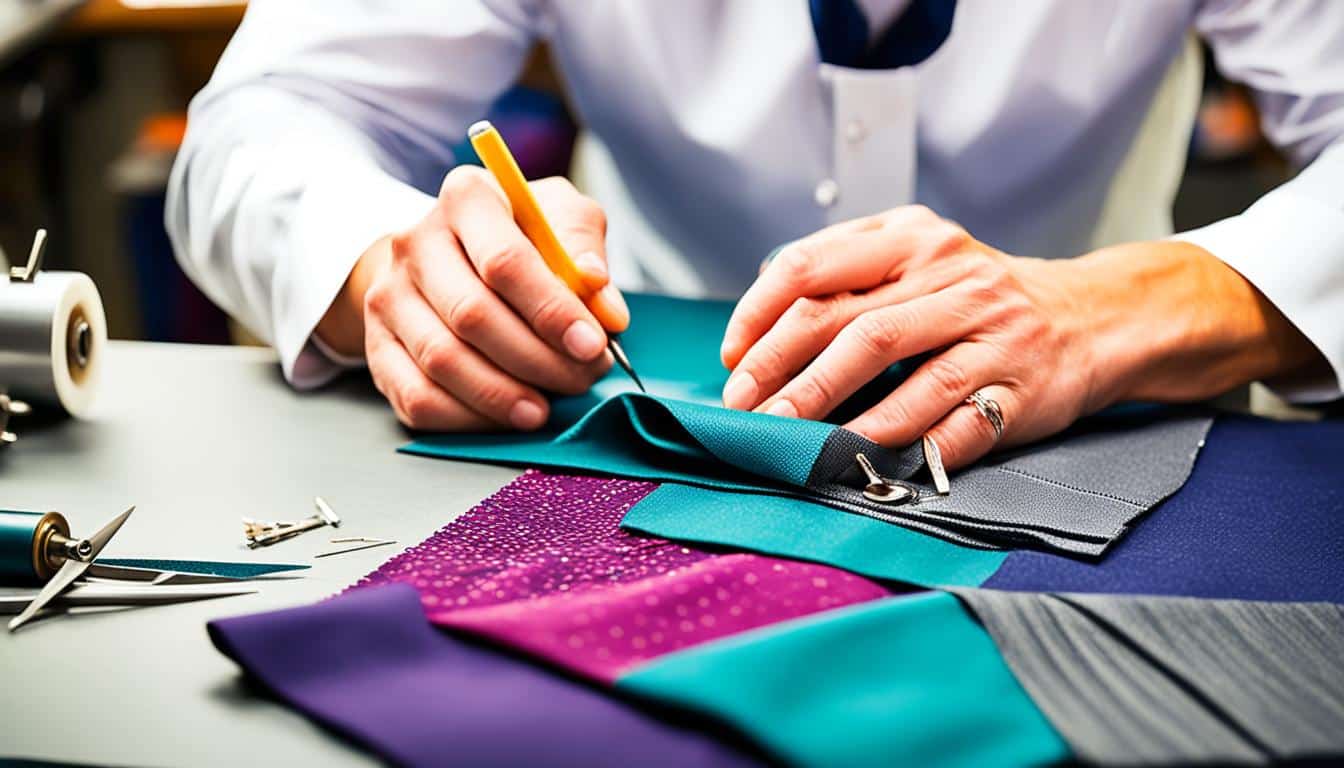Fashion design is a versatile and exciting hobby that goes beyond mere aesthetic choices. It has the power to transform your family’s style and make a lasting impact on your wardrobe. By delving into the world of fashion design, you can explore garment construction techniques, stay ahead of the latest fashion trends, and unleash your creativity in unique ways.
Whether you are designing clothes for your children or yourself, fashion design allows you to make personalized choices that reflect your style and ideas. From choosing the perfect fabric to experimenting with color schemes and patterns, every step of the design process is an opportunity for self-expression and creativity.
But fashion design is not just about creating beautiful garments. It also involves understanding the art of garment construction, ensuring that your designs are not only visually appealing but also of high quality and durability. By acquiring knowledge in this area, you can create pieces that stand the test of time and become wardrobe staples for your family.
Key Takeaways : Fashion Design
- Fashion design allows you to express your creativity and make unique aesthetic choices.
- It goes beyond clothing and encompasses garment construction techniques for quality and durability.
- Staying updated with fashion trends helps your family’s style evolve with current styles.
- Fashion design offers a platform to showcase your personal style and ideas.
- Explore different fabric options, color schemes, and patterns to elevate your designs.
The Basics of Fashion Design and Its Benefits for Children
Fashion design is not just for adults – it is a valuable hobby for children that offers a range of benefits. Engaging in fashion design activities helps children develop a strong sense of individuality and self-expression. Through the creative process of designing and making clothing, children have the opportunity to explore their unique style and showcase their personality through their creations.
Furthermore, fashion design fosters essential skills such as problem-solving and critical thinking. When children design their own garments, they are faced with various challenges that require them to think critically and find creative solutions. Whether it’s figuring out how to create a specific silhouette or choosing the right fabrics and colors, fashion design encourages children to problem-solve and think outside the box.
In addition to nurturing problem-solving and critical thinking skills, fashion design activities also enhance hand-eye coordination. From sketching their designs to cutting and sewing fabrics, children learn to coordinate their hand movements with their visual perception. This development of hand-eye coordination can have a positive impact on their overall motor skills and dexterity.
Fashion design is a form of artistic expression that allows children to explore their imagination and creativity. By experimenting with different colors, textures, and styles, they can design unique and visually appealing garments that reflect their individual taste. This process not only boosts their creativity but also instills the value of self-expression.
In summary, fashion design is an enriching hobby for children that goes beyond creating stylish outfits. It cultivates problem-solving and critical thinking abilities, enhances hand-eye coordination, and fosters imagination and creativity. So, encourage your child to explore the world of fashion design and watch as their skills and self-expression flourish.
Exploring Fabrics and Textiles in Fashion Design
Fabrics and textiles are the building blocks of fashion design. They play a crucial role in determining the look, feel, and functionality of garments. Whether you’re creating fashionable clothing, designing home decor accessories, or upholstering furniture, understanding the characteristics of different fabrics and textiles is essential.
When it comes to fabric choices, the options are vast. From the softness of cotton to the luxuriousness of silk and the practicality of polyester, each fabric offers unique qualities that can enhance your designs. Cotton is a popular choice due to its breathability and comfort, making it ideal for everyday clothing. Silk, on the other hand, exudes elegance and sophistication, perfect for special occasions. Meanwhile, polyester’s durability and easy maintenance make it a practical choice for upholstery and home decor.
But it’s not just the type of fabric that matters; the weave and texture also come into play. Different weaves, such as twill, satin, and plain weave, create distinct visual and tactile effects. Twill weaves, characterized by their diagonal lines, add depth and dimension to garments. Satin weaves, known for their smooth and lustrous finish, exude luxury. Plain weaves, the most common and simple weave, offer versatility and a balanced texture for various fashion applications.
Understanding the properties of different fabrics and textiles empowers you to make informed design decisions. It allows you to align the fabric’s characteristics with your design goals, ensuring the desired look, comfort, and functionality. Whether you’re aiming for a breezy summer dress, a cozy home decor piece, or a durable upholstered furniture item, choosing the right fabric is key to achieving your vision.
Common Fabrics and Their Characteristics
| Fabric | Characteristics |
|---|---|
| Cotton | Soft, breathable, hypoallergenic |
| Silk | Luxurious, smooth, lightweight |
| Polyester | Durable, wrinkle-resistant, easy to care for |
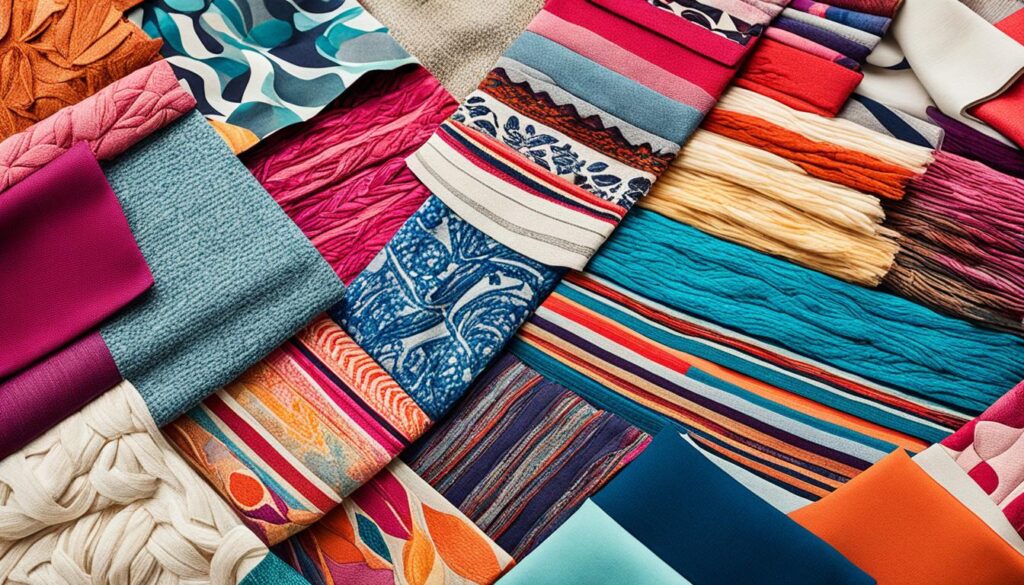
“The fabric you choose can make or break your design. It’s not just about aesthetics; it’s about the feel and performance of your garments. Be intentional in your fabric selection, and you’ll elevate your fashion designs to the next level.”
Exploring the world of fabrics and textiles opens up endless creative possibilities. By understanding the unique characteristics of each fabric and the effects of different weaves, you can bring your fashion design ideas to life. So go ahead, experiment with different fabrics, textures, and weaves, and create garments that showcase your style and expertise.
Using Mood Boards for Outfit Inspiration in Fashion Design
When it comes to fashion design, finding inspiration for new and exciting outfit ideas is essential. One tool that can help you in this creative process is a mood board. Mood boards are visual collages that bring together images, colors, and textures that reflect your personal style and the latest trends. They serve as a source of visual inspiration, helping you develop a cohesive and unique wardrobe.
Creating a mood board is a simple yet effective way to explore different outfit ideas and experiment with various styles. Start by gathering images from magazines, fashion blogs, or online platforms that resonate with your personal style and capture your attention. Look for images that showcase specific trends, interesting color combinations, or unique clothing pieces. Don’t be afraid to mix and match different styles to create a visually compelling mood board.
Once you have collected a range of images, arrange them on a physical or digital board in a way that feels visually appealing to you. Consider the colors, patterns, and textures presented in each image and think about how they can be incorporated into your own outfits. Use the mood board as a guide for styling your clothing, accessories, and even hairstyles.
Mood boards also help you identify key themes and motifs that you can integrate into your personal style. They allow you to visualize the overall aesthetic you want to achieve and make more intentional fashion choices. By referring to your mood board regularly, you can stay updated with the latest trends and ensure that your outfits are on-point and visually inspiring.
Not only do mood boards serve as a source of outfit inspiration, but they also encourage you to think outside the box and push the boundaries of your personal style. They open up a world of possibilities, allowing you to experiment with different color combinations, silhouettes, and accessory pairings. Whether you’re a fashion enthusiast or a professional designer, incorporating mood boards into your creative process can transform the way you approach fashion design.
Benefits of Using Mood Boards in Fashion Design:
- Generate ideas and inspiration for new outfit combinations.
- Visualize the overall aesthetic and style you want to achieve.
- Stay updated with the latest fashion trends.
- Identify key themes and motifs for a cohesive wardrobe.
- Encourage creativity and experimentation with different styles and colors.
- Make more intentional fashion choices.
By incorporating mood boards into your fashion design process, you can unlock a world of creativity and personal expression. Embrace the power of visual inspiration and let your mood board guide you in creating unique and stylish outfits that reflect your personal style and current trends.
The Role of Color Schemes and Patterns in Fashion Design
In the world of fashion design, color schemes and patterns play a crucial role in creating visually captivating garments. By understanding color theory and utilizing different patterns, designers can elevate their creations and enhance the overall aesthetic appeal.
Creating Visual Interest with Color Schemes
Color schemes are combinations of colors that are strategically chosen to evoke specific emotions and create visual impact. Designers use color schemes to create contrast, highlight focal points, and establish a cohesive look. Each color has its own significance and can convey different moods and emotions. By carefully selecting and combining colors, designers can enhance the overall visual interest of their designs.

For example, a vibrant and bold color scheme can create a statement-making design, while a monochromatic color scheme can evoke a sense of sophistication and elegance. Complementary colors, situated opposite each other on the color wheel, create a striking contrast that catches the eye. Analogous colors, which are adjacent on the color wheel, create a harmonious and cohesive look.
Adding Texture and Dimension with Patterns
Patterns are a powerful tool in fashion design to add texture and dimension to garments without overwhelming the overall aesthetic. Different patterns can create visual interest and evoke specific emotions. From florals and stripes to geometrics and abstract designs, the possibilities are endless. Designers carefully select patterns that align with the desired style and message of their collections.
“Patterns can be used strategically to accentuate certain areas of a garment or create a sense of movement within the design. They can add depth and create a multi-dimensional visual experience for the viewer.”
Patterns can be used in various ways, such as all-over prints, accent details, or as contrasting elements. Combining patterns with solid colors can create a balanced and visually appealing look. Designers experiment with different pattern sizes, placements, and combinations to create unique and eye-catching designs.
Integrating Color Schemes and Patterns
The integration of color schemes and patterns is where the true magic happens in fashion design. By strategically combining colors and patterns, designers can create visually captivating looks that leave a lasting impression. The right combination can enhance the silhouette, draw attention to specific elements of a design, and create a harmonious overall aesthetic.
Incorporating contrasting colors within a pattern can create intrigue and draw the eye to specific areas of a garment. Combining different patterns in a cohesive color palette can add depth and create a dynamic visual impact. Designers carefully evaluate color schemes and patterns to ensure they align with the overall concept and message of their designs.
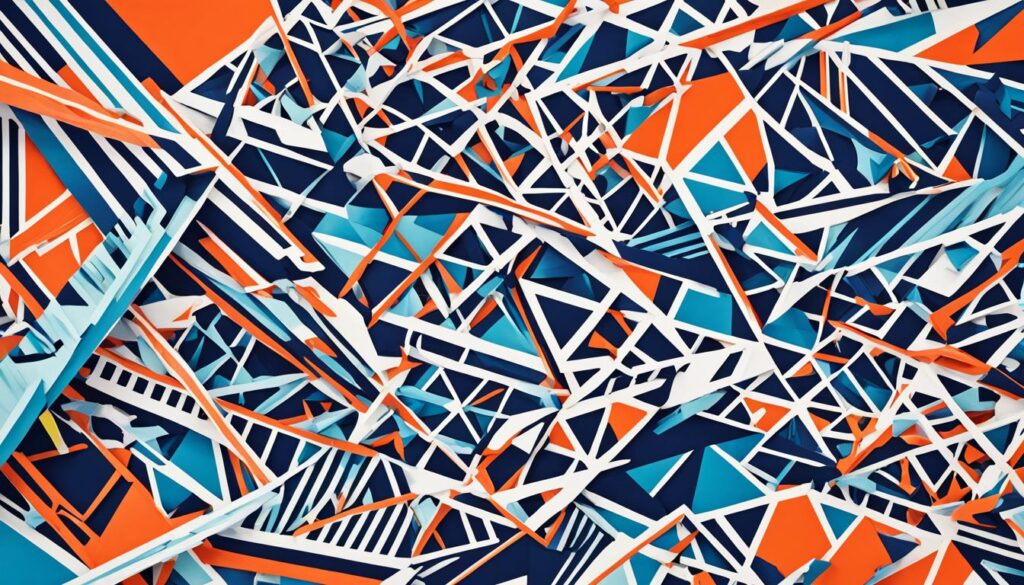
| Color Scheme | Pattern | Visual Impact |
|---|---|---|
| Monochromatic | Stripes | Modern and graphic |
| Analogous | Florals | Feminine and romantic |
| Complementary | Geometrics | Dramatic and bold |
As fashion trends evolve, so do color schemes and patterns. Designers must stay updated with the latest trends and experiment with new combinations to keep their designs fresh and relevant.
By harnessing the power of color schemes and patterns, fashion designers can create visually striking garments that captivate the viewer’s attention and leave a lasting impression.
Upcycling and Sustainability in Fashion Design
Upcycling has gained significant traction in the fashion industry as a sustainable alternative. This creative and rewarding activity promotes sustainability and environmental consciousness by repurposing found objects and materials that would otherwise be discarded as waste. Fashion designers embrace upcycling to create new and unique pieces while actively reducing waste in landfills.
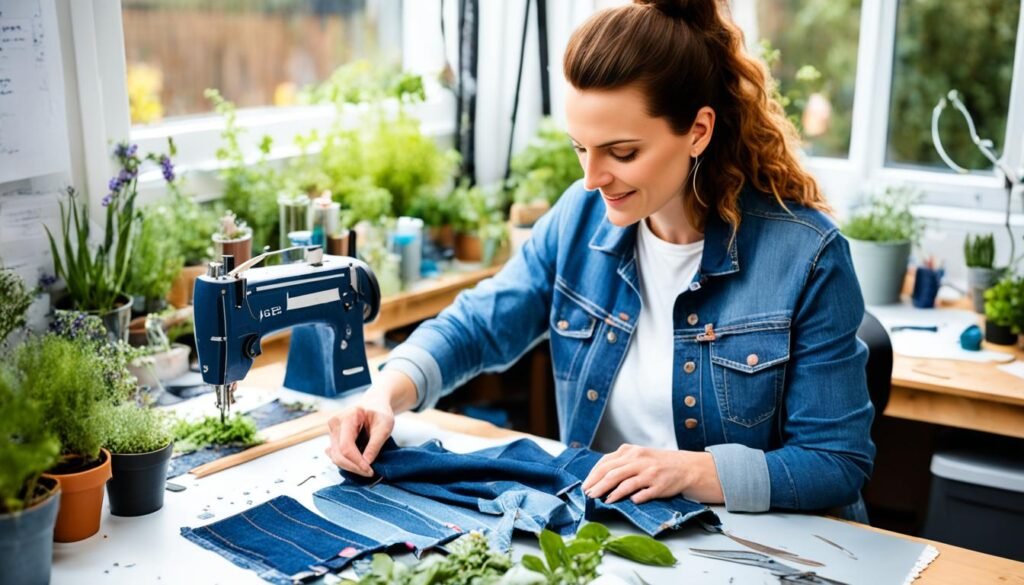
Through upcycling, designers can transform ordinary objects into extraordinary fashion statements. It allows for the exploration of unconventional materials and offers endless possibilities for innovation and creativity. By upcycling, designers contribute to the reduction of waste and the conservation of natural resources.
Upcycling.”Reduce, reuse, and recycle” is the core ethos of upcycling—giving new life and purpose to objects that have lost their original utility. It is a sustainable practice that aligns with the principles of circular economy and responsible consumerism.
DIY projects play a significant role in upcycling within the fashion industry. Designers and individuals alike are encouraged to embark on their own upcycling endeavors, transforming old garments, accessories, or household items into valuable and unique pieces. These DIY upcycling projects not only reduce waste but also provide an opportunity for personal expression and customization.
Benefits of Upcycling in Fashion Design:
- Sustainability: Upcycling reduces the demand for new materials and minimizes the environmental impact of production processes.
- Creativity and Innovation: Upcycling encourages designers to think outside the box and experiment with unconventional materials and techniques.
- Unique and One-of-a-Kind Pieces: Upcycled fashion pieces are distinct, ensuring that individuals can showcase their personal style and stand out from the crowd.
- Reducing Waste: By giving new life to discarded objects, upcycling helps divert items from landfills, contributing to waste reduction efforts.
- Community Engagement: Upcycling promotes community collaboration and participation through DIY workshops, upcycling events, and knowledge sharing.
Real-Life Examples of Upcycling in Fashion Design:
| Brand/Designer | Upcycling Project |
|---|---|
| Patagonia | Worn Wear Program: Repairing and refurbishing old Patagonia garments to extend their lifespan. |
| Stella McCartney | Using vegan leather made from upcycled textiles and innovative materials. |
| Reformation | Creating garments from end-of-roll and surplus fabrics to minimize waste. |
Upcycling presents a unique opportunity for fashion enthusiasts to contribute to a more sustainable future while expressing their individuality through creative and eco-friendly fashion choices. By incorporating upcycled pieces into their wardrobes, individuals can make a positive impact on both the environment and the fashion industry.
Understanding Garment Construction Techniques in Fashion Design
Garment construction techniques are fundamental to the field of fashion design as they directly impact the quality and durability of the final product. Fashion industry professionals must possess a comprehensive understanding of different techniques, including flat pattern, draping, and computer-aided design, to create outstanding designs and long-lasting garments.
The Importance of Garment Construction Techniques
Garment construction techniques encompass a range of methods used to transform fabric into a finished garment. These techniques dictate how the fabric is cut, shaped, and assembled, ultimately determining the fit, quality, and functionality of the clothing. By mastering various techniques, fashion designers can ensure that their creations meet the highest standards of quality and durability.
Flat Pattern Technique
The flat pattern technique is a foundational method in garment construction. It involves creating a paper pattern based on precise measurements and design specifications, which is then used to cut the fabric and sew the garment together. This technique allows designers to achieve accurate and consistent sizing, ensuring that their designs fit well on a range of body types.
Draping Technique
The draping technique involves manipulating fabric directly on a dress form or live model to create the desired shape and fit of a garment. This hands-on approach allows designers to experiment with different silhouettes, drape the fabric to their vision, and make adjustments in real-time. Draping offers a high level of creativity and artistry, as it allows designers to explore the fluidity and movement of the fabric.
Computer-Aided Design (CAD)
Advancements in technology have revolutionized the fashion industry, and computer-aided design (CAD) plays a significant role in garment construction. CAD software allows designers to create digital patterns, make alterations, and visualize the final garment in a virtual environment. This technology streamlines the design process, enhances precision, and facilitates collaboration between designers, pattern makers, and manufacturers.
By utilizing CAD software, fashion designers can quickly iterate on their designs, test different colorways, and ensure accuracy before proceeding to the physical production stage. This not only saves time but also minimizes material waste, contributing to a more sustainable approach to garment construction.
Quality and Durability
Garment construction techniques influence the quality and durability of the final product. By employing meticulous construction methods and choosing suitable materials, designers can create garments that withstand wear and maintain their shape over time. Attention to detail in stitching, seam finishes, and overall construction ensures that garments meet the highest standards of quality.
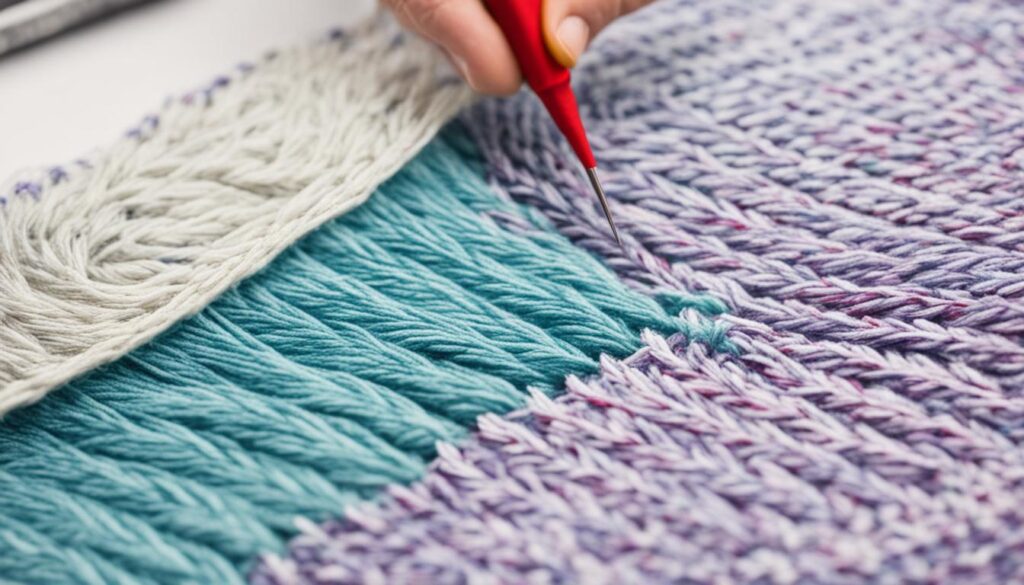
The image above illustrates the intricate process of garment construction, showcasing the skills and techniques employed by fashion industry professionals.
By understanding and mastering garment construction techniques such as flat pattern, draping, and computer-aided design, fashion designers can create exceptional designs that embody both quality and durability. These techniques provide the foundation for crafting garments that stand the test of time and make a lasting impression in the world of fashion.
Fashion Design as a Career Choice
Fashion design offers a fulfilling and exciting career path for individuals who are passionate about creativity and style. Whether you dream of designing runway collections or creating your own fashion brand, pursuing a fashion design education is a crucial first step towards success in the industry.
There are various avenues for obtaining a fashion design education, including degree programs offered by prestigious fashion schools or specialized courses that focus on specific aspects of the field. These educational opportunities provide aspiring designers with essential skills and knowledge in areas such as garment construction, sketching, pattern-making, and textile analysis.
Once equipped with a solid foundation in fashion design, graduates have the flexibility to choose from a diverse range of work environments. Some designers thrive in bustling design studios, collaborating with teams to create innovative collections. Others find fulfillment in the fast-paced environment of fashion houses, working closely with production teams to bring their designs to life.
While the salary in the fashion industry can vary depending on factors such as experience, location, and job role, successful designers have the opportunity to earn a lucrative income. Established designers who have built a strong reputation and cultivated a loyal clientele often enjoy significant financial rewards.
In addition to financial incentives, a career in fashion design offers unparalleled opportunities for creativity, self-expression, and personal fulfillment. Designers have the privilege of turning their ideas into tangible creations, playing an instrumental role in shaping the fashion industry and leaving their mark on the world of style.
Moreover, the fashion industry offers a dynamic and ever-evolving work environment, constantly pushing designers to innovate and stay on top of emerging trends. This sense of constant change and excitement ensures that no two days in the fashion world are ever the same.
The Versatility of a Fashion Design Career
One of the greatest benefits of a fashion design career is its versatility. Fashion designers can explore various niches and specialties, including:
- Haute couture: Designing one-of-a-kind, high-end garments for exclusive clients
- Ready-to-wear: Creating collections of off-the-rack clothing for mass production
- Accessory design: Designing handbags, shoes, and other fashion accessories
- Costume design: Creating costumes for theater, film, and television productions
- Visual merchandising: Styling and curating visual displays in retail environments
This versatility allows fashion designers to explore their passions and interests while honing their skills in specific areas of expertise. It also opens doors to collaborations with other creative professionals and the potential to branch out into related fields such as fashion journalism, fashion photography, or fashion event management.
Achieving Success in the Fashion Industry
While passion and creativity are essential for a fashion design career, they must be balanced with a strong work ethic, resilience, and a commitment to continuous learning. Building a successful fashion design career requires dedication, perseverance, and a willingness to embrace new opportunities and challenges.
Networking is also crucial in the fashion industry, as it allows designers to connect with potential clients, employers, mentors, and collaborators. Attending fashion events, joining industry organizations, and utilizing social media platforms can help aspiring designers establish valuable connections and gain exposure in the industry.
In conclusion, a career in fashion design offers the perfect blend of creative fulfillment, professional growth, and financial rewards. By pursuing a fashion design education, aspiring designers can equip themselves with the necessary skills and knowledge to thrive in the industry. With dedication, perseverance, and a passion for style, the possibilities within the fashion design career are limitless.
| Pros of a Fashion Design Career | Cons of a Fashion Design Career |
|---|---|
|
|
Connecting Fashion Design to Personal and Family Style
Fashion design has a direct impact on personal and family style. It provides a platform for individuals to showcase their creativity and express their personal style through unique garments. By carefully selecting fabrics, colors, and patterns, fashion designers can create pieces that reflect their individuality and aesthetic preferences. This personal touch adds a distinct flair to their wardrobe and allows them to stand out from the crowd.
Staying updated with fashion trends is also essential in connecting fashion design to personal and family style. By keeping an eye on the latest fashion trends, individuals can incorporate current styles into their own wardrobe, adding a touch of modernity to their personal style. Whether it’s embracing a new color scheme, experimenting with different silhouettes, or incorporating trendy accessories, fashion design allows individuals to be at the forefront of fashion.
Furthermore, fashion design provides a platform for self-expression and creativity. It allows individuals to experiment with different styles, mix and match diverse elements, and create unique looks that reflect their personality and interests. Fashion designers have the freedom to play with textures, experiment with layering, and explore various fashion aesthetics, enabling them to curate a wardrobe that truly represents who they are.
When it comes to family style, fashion design has the power to enhance the overall aesthetic and create a cohesive look for the entire family. By designing and creating garments that complement each other, families can establish a unified style that showcases their creativity and individuality. Whether it’s coordinating color schemes, incorporating matching patterns, or designing custom pieces for special occasions, fashion design offers endless possibilities for expressing family style.
In summary, fashion design goes beyond just creating clothing. It provides individuals with the opportunity to express their personal style, stay updated with current fashion trends, and unleash their creativity. Fashion design has the power to enhance personal and family style, allowing individuals to make a statement and showcase their unique sense of fashion.
Also Read : Trendy Fashion Footwear for All Seasons – Shop Now!
Conclusion
Fashion design has a profound impact on personal and family style, allowing individuals to express their creativity and showcase their unique sense of fashion. Through the process of designing and creating garments, people have the opportunity to explore their creativity and create pieces that reflect their individuality. By embracing fashion design, families can elevate their style and create a wardrobe that truly represents their personality.
Moreover, fashion design goes beyond just aesthetic choices. It helps develop critical skills such as problem-solving and attention to detail, which are essential in various aspects of life. The process of creating a garment requires careful thought, planning, and execution, nurturing a sense of perseverance and precision.
Ultimately, fashion design is not just a hobby or a career path but a means of personal expression. It allows individuals to communicate their unique ideas and perspectives through clothing, breaking free from societal norms and embracing their true selves. By embracing fashion design, individuals can cultivate a lifelong passion for creativity and self-expression, positively impacting their family’s style and leaving a lasting mark on the world of fashion.
FAQs
Q: What is the role of a fashion designer?
A: A fashion designer is responsible for creating original clothing, accessories, and footwear designs.
Q: How can attending a fashion show benefit a fashion design student?
A: Attending a fashion show allows a fashion design student to observe current trends, gain inspiration, and network with industry professionals.
Q: What is the significance of fashion week in the fashion industry?
A: Fashion week is a prestigious event where designers showcase their latest collections to buyers, press, and the public, setting trends for the upcoming season.
Q: How does a fashion design program prepare students for a career in the industry?
A: A fashion design program equips students with skills in apparel creation, design thinking, sewing techniques, and the business of fashion, setting them up for a successful career.
Q: What are some common career paths for fashion design students after graduation in 2023?
A: Graduates of fashion design programs can pursue roles such as apparel designer, technical designer, fashion merchandiser, or work in the business side of the fashion industry.
Q: How important is it for fashion design students to secure internships during their studies?
A: Internships are crucial for fashion design students to gain real-world experience, build their portfolio, and establish industry connections for future employment opportunities.
Q: What happens at an annual fashion show organized by a school of design?
A: An annual fashion show organized by a school of design typically showcases student work, presents collections created throughout the year, and provides students with a platform to exhibit their designs.
